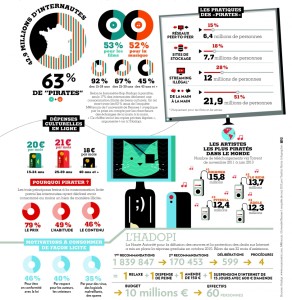Dans notre dernière note de lecture, nous avions conclu, à la lumière du texte Cyber-Marx, que sitôt que les forces ouvrières s’organisaient pour échapper au capital, par exemple en partageant des biens d’information par Internet (par le peer to peer), le capital trouvait une entourloupe pour briser cette cohésion. Les textes de ce septième cours offre un regard entre autres sur les distinctions entre le « vrai pirate » et le dilletante en la matière, dit « partisan » chez Andersson.
At the same time, in another peripheral European country, the Swedish people have been complicit in the “crime” of embracing an infrastructure that has exposed what a house of cards the established economy of cultural consumption is.
Given the theme of this publication, where do we place the ‘pirate’ in all of this? First of all, in my own research I have found that file-sharers themselves make a central distinction between ‘pirate copying’ and ‘private copying’.
Remarques sur les distinctions pirate et « partisans » : Partisans are non-regular troops, bordering between the civilian and the military, occasionally embodying a political stance as they shift between roles in a tellurian manner. (…) True pirates are defined by a consequence-neutral stance bordering on the nihilist.
Dans le texte de Mattelart, on rappelle comment les États-Unis, après avoir eux-mêmes largement profité de ces circuits souterrains ont succombé à la pression des producteurs d’Hollywood et décidé d’inscrire la lutte contre le piratage des biens culturels comme une priorité.
Cours 7 –Piracy, Distribution and Circulation
Andersson, J. (2011). “It Takes (at Least) Two to Tango.” Re-Public: Re-Imagining Democracy. https://web.archive.org/web/20130824095524/http://www.re-public.gr/en/?p=3878
Benson-Allott, C. (2013). Killer Tapes and Shattered Screens: Video Spectatorship From VHS to File Sharing. Berkeley: University of California Press. Chapter 5
Eichhorn, K. (2015). Copy Machines and Downtown Scenes: Deterritorializing urban culture in a pre-digital era. Cultural Studies,29(3), 363–378. http://www.tandfonline.com/doi/abs/10.1080/09502386.2014.937940?journalCode=rcus20
Meng, B. (2012). Underdetermined Globalization: Media Consumption via P2P Networks. International Journal Of Communication, 6, 17. Retrieved from http://ijoc.org/index.php/ijoc/article/view/1258
Pick one country from either:
Karaganis, J. (2013). Media Piracy in Emerging Economies. CreateSpace Independent Publishing Platform or
Mattelart, T. (2011). Piratages audiovisuels : Les voies souterraines de la mondialisation culturelle. Bruxelles: De Boeck.
Huizing, A., & van der Wal, J. A. (2014). Explaining the rise and fall of the Warez MP3 scene: An empirical account from the inside.First Monday, 19(10). Retrieved from http://firstmonday.org/ojs/index.php/fm/article/view/5546
Johns, A. (2009). Piracy as a business force. Culture Machine, 10, 44–63. http://davaotoday.com/main/wp-content/uploads/2009/07/STUDY-ROOM-2.pdf

